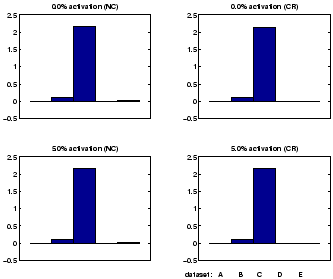


Next: Choice of Template Image
Up: Accuracy Assessment: Motion Correction
Previous: Cost Functions
To further improve the accuracy of the motion estimates, the next
parameter we experimented with was the choice of interpolation scheme
for the motion estimation. In addition to the standard tri-linear
scheme, a windowed-sinc interpolation (using a Hanning window of size
 )
was tried. While considerably slower than trilinear interpolation,
the sinc approach is able to further refine motion estimates after the
initial trilinear stage has converged on a solution thus providing
greater accuracy. The results in Figure 14 show
the greater degree of accuracy achieved over using trilinear
interpolation alone. Note that on the third data set (cropped to allow distinction between the other four sets), the improvement was consistently over a value of 2.0.
)
was tried. While considerably slower than trilinear interpolation,
the sinc approach is able to further refine motion estimates after the
initial trilinear stage has converged on a solution thus providing
greater accuracy. The results in Figure 14 show
the greater degree of accuracy achieved over using trilinear
interpolation alone. Note that on the third data set (cropped to allow distinction between the other four sets), the improvement was consistently over a value of 2.0.
Figure 14:
Median (over time) RMS (over space) error results for the MCFLIRT scheme applied to synthetic data exhibiting known motion of one of five designs and audiovisual activation at increasing intensities. A positive value indicates improved accuracy as a result of incorporating the final sinc interpolation stage. Cost function notation corresponds to Table 1 and demonstrates the improvement in accuracy achieved by using smoothed cost functions and additional sinc interpolation when compared to the basic trilinear scheme reported in Figure 13
 |



Next: Choice of Template Image
Up: Accuracy Assessment: Motion Correction
Previous: Cost Functions
Peter Bannister
2002-05-03

